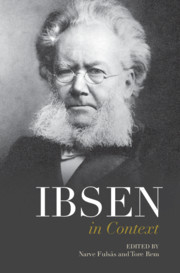Book contents
- Ibsen in Context
- Ibsen in Context
- Copyright page
- Contents
- Figures
- Contributors
- Preface
- Notes on the text
- Chronology
- Part I Life and Career
- Part II Culture and Society
- Chapter 4 Genres
- Chapter 5 Realism
- Chapter 6 Theatre
- Chapter 7 Visual Arts
- Chapter 8 Music
- Chapter 9 Philosophy
- Chapter 10 Science
- Chapter 11 Feminism
- Chapter 12 Capitalism
- Part III Scandinavian Reception
- Part IV Internationalization
- Part V Afterlives
- Further Reading
- Index
Chapter 8 - Music
from Part II - Culture and Society
Published online by Cambridge University Press: 23 April 2021
- Ibsen in Context
- Ibsen in Context
- Copyright page
- Contents
- Figures
- Contributors
- Preface
- Notes on the text
- Chronology
- Part I Life and Career
- Part II Culture and Society
- Chapter 4 Genres
- Chapter 5 Realism
- Chapter 6 Theatre
- Chapter 7 Visual Arts
- Chapter 8 Music
- Chapter 9 Philosophy
- Chapter 10 Science
- Chapter 11 Feminism
- Chapter 12 Capitalism
- Part III Scandinavian Reception
- Part IV Internationalization
- Part V Afterlives
- Further Reading
- Index
Summary
Ibsen has not often been regarded as a writer who was especially sympathetic to music or concerned with the acoustic dimensions of his work. But close attention to the practical conditions in which he first worked as a theatre director in Bergen, and to the textual details of his plays, suggests instead a fine feeling for sound and musical affect. This chapter summarizes his early writing on opera, his interest in the relationship between music and theatre, and examines the symbolic role of sound and music in some key passages from his work, including Peer’s wild ‘halling’, Nora’s tarantella, and Hedda’s famous gunshot.
- Type
- Chapter
- Information
- Ibsen in Context , pp. 65 - 73Publisher: Cambridge University PressPrint publication year: 2021
- 2
- Cited by

